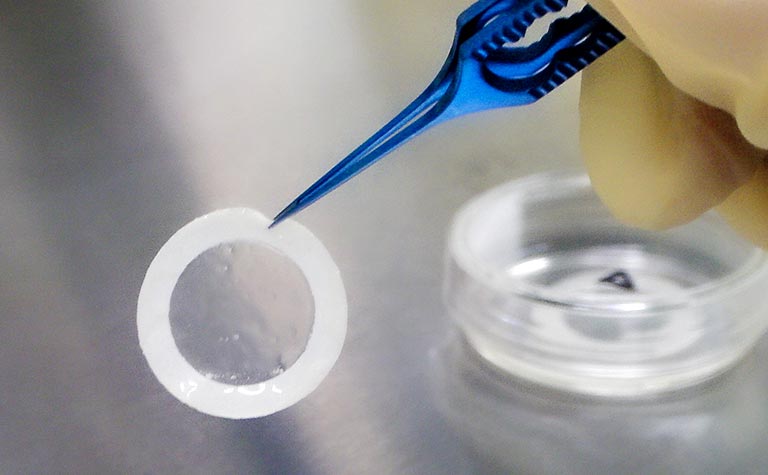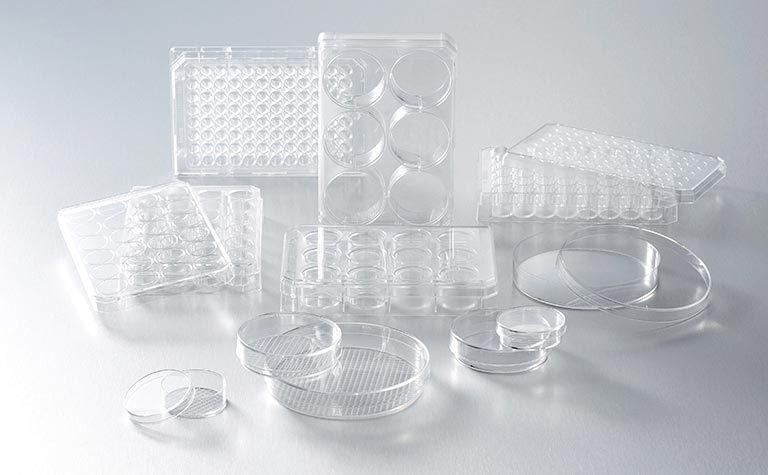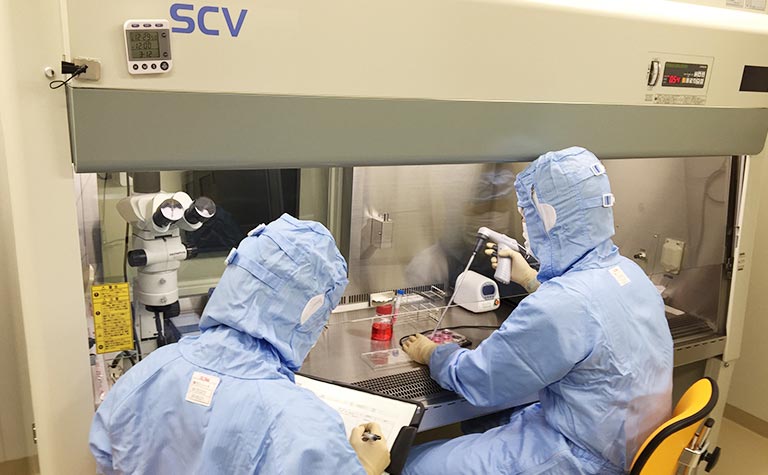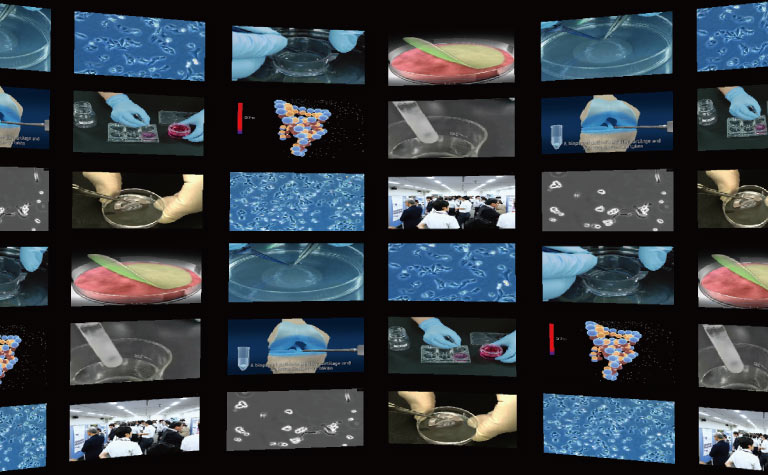FAQ
- Temperature-responsive polymer (PIPAAm)
- UpCell®
- RepCell®
- HydroCell®
- Does the temperature-responsive polymer (PIPAAm) come off with cells?
-
The polymer is covalently bonded to the surface of the polystyrene therefore it does not come off as long as the product is used in the "normal course of cell culture".
- Does this polymer make cells easier to attach when coated?
-
This polymer allows detachment of cells proteins without causing any damage to them by mere reduction of temperature. Hence it does not make the surface of the dish easier to attach for cells.
- Why cells are easier to detach when the temperature is reduced?
-
The polymer immobilized surface changes from slightly hydrophobic to super hydrophilic state across the transition temperature of 32℃ (LCST=lower critical solution temperature). The cells lose their anchorage when the surface becomes hydrophilic, prompting cells to detach.
- Any constraints as to the materials to be coated with this polymer?
-
At the moment, the polymer can only be fixed to the organic substance such as platics without incurring any additional research/development. However we can not fix polymer to the paper though is is also organic substance. Apart from this, we would require additional research for fixing polymer to the glass or steels.
- Any constraints as to the shape of the surface to be coated with this polymer?
-
If the organic substance to be coated with polymer is ball-shaped or round shaped, we need some time to develop suitable technique.
- Can you change the LCST (lower critical solution temperature) of 32℃?
-
Yes, it is possible to change LCST. For further information please contact here.
- Is there any cell toxicity of the PIPAAm?
-
The safety of the polymer has been subjected against the rigorous test in accordance with ISO 10993.
- What is the storage condition of UpCell®?
-
Please store the product at room temperature. Please avoid direct exposure to sunlight.
- Is UpCell® suitable for repeated usage?
-
UpCell® is designed for single time use only.
- What are the tips for using UpCell®?
-
"Immediately after seeding" to "upto 24 hours"
(1) Please make sure to use cell culture medium pre-warmed at 37℃.
(2) Try not to lower incubation temperature lower than 37℃.
(3) Avoid direct shock to UpCell®.
(4) As much as possible, leave UpCell® undisturbed for the first 24 hours of incubation."During cell culture beyond 24 hours"
Avoid observation under microscope at room temperature for long period of time.
"Medium change"
Make sure to change cell culture medium that is pre-warmed at 37℃./p>
- Please advise how to collect cell-sheet?
-
Please refer to the data page.
- Please advise the pit falls when collecting cell-sheet?
-
Please refer to the data page.
- Is usage of UpCell® and the supporting membrane essential when collecting cell-sheet?
-
It is essential to use UpCell® when collecting cells as a "cell-sheet". However you can use hygroscopic PVDF membranes as an alternative to the supporting membranes. Please note that optimum protocol may vary by the type of membranes used.
- What should be done when cells cannot be collected as a cell-sheet even if UpCell® and the supporting membranes are used?
-
The optimum cell-sheet detachment protocol may vary by (1) cellt ype, and (2) culture condition such as cell density, culture period or culture medium. Some optimization may be required. Please refer to Q4 and Q5 for further information.
- Do cells detach from UpCell® when the dish is left at room temperature?
-
It may take a while for cells to detach from UpCell® surface until it becomes hydrophilic, which occurs at temperature lower than LCST of 32℃. Therefore followings should be noted.
- Please make sure to use pre-warmed culture medium whenever changing the culture medium.
- Beware of time required to change the culture medium. taking too much time to change the culture medium will lower the temperature below LCST.
- Avoid direct shock to UpCell. Especially cells that had just started to form cell-cell junction are fragile to external shock and may detach by such shock.
- Usage of such temperature preserving device as hot plate enables you to work longer at room temperature.
- How can I purchase temperature-responsive cell culture insert?
-
The temperature-responsive cell culture insert is still under development. The launch schedule shall be advised on this website when known.
- How can I cryofracture the cell-sheet? How about making paraffin-embedded section with cell-sheet?
-
Please refer to the data page for further information.
- What is the protocol of collagen type I coating for UpCell®?
-
Please refer to the data page for further information.
- What kind of gel is recommended to practice with when transferring cell-sheet harvested from UpCell®?
-
We recommend you to practice with 15% acrylamide gel of SDS-PAGE that is shown in our HP. We also recommend using 7.5% Gelatin gel. However we don't recomend gel with low stickiness such as Agarose.
- What is the difference between UpCell® and RepCell® (UpCell® with Grid)?
-
Both products are covalently grafted with temperature-responsive polymer. However only RepCell® is equipped with 3mm x 3mm of grid walls on the surface of the culture dishes. Grid walls inhibit cells from crossing over them thus enabling easier collection of cells in a form of single cells or in a form of small colonies. Suitable for preparation of cells for flowcytometry analysis. Beware that RepCell® (UpCell® with Grid) is not suitable for collecting cell-sheet.
- Does the collected grouped cells become single cell suspension?
-
Generally speaking, cells with weak cell-cell junction property can be split easily by gentle media pipetting. Please note that the result may vary by cell type and cell culture conditions.
- Do you need special incubator capable of setting temperature at 20℃?
-
Temperature can also be controlled by leaving UpCell® at room temperature (20-25℃). Please note that cell detachment performance is constant below 32℃, i.e. hydrophilicity of the surface is constant at temperature below LCST therefore too cold the temperature may deprive of cell ATP metabolism, making cell detachment even more difficult.
- Can you coat the UpCell® surface with gellatin or collagen?
-
Yes, you can. In so doing, coating procedure should be done at 37℃. Please note that growth speed of cells may become slower due to this extra surface treatment.
- What kind of cells are you targeting?
-
You can culture almost any type of cells like fibroblast such as NIH/3T3, Swiss/3T3 or 10T1/2, mesenchymal stem cells, myoblast or cancer cells. However cells with very strong adherence property may not be detachable with simple temperature reduction. Simultaneous use of diluted trypsin is highly recommended for such case.
- What options do you have when cells do not come off?
-
When cells do not come off spontaneously from UpCell® surface by simple temperature reduction, please gently pipett adhered cells with cell culture medium., or gently tap the edge of the dish to prompt cell detachment.
- Do you need to use RepCell® (UpCell® with Grid) instead of UpCell® if you wish to collect cell in a form of single cell suspension?
-
By seeding cells in low density, you can still collect intact single cell suspension by using UpCell®. However RepCell® (UpCell® with Grid) is more suitable for such purpose. Following are the recommended protocols for intact single cell collection.
- When cell-cell junction is tight/strong.
Seed cells whose density is so low that cells do not stick to each other. Incubate and harvest within 24 hours before cells start to proliferate again. - When cell-cell junction is fragile/weak.
Culture cells upto 70-80% of confluency, and collect cells by temperature reduction. Clumped cells can be made to single isolated cells by slight agitation by media pipetting.
- When cell-cell junction is tight/strong.
- What are the other uses than culturing immune cells such as macrophage?
-
We recommend such uses as...
- Formation of embryoid ES cells
- Anchorage independent colony formation of cancer cells
- Spheroid formation
- ulture of neurosphere or cancer cells
- Cells adhered to surface of the HydroCell®. What can you do to prevent it?
-
Cells that produce relatively high amount of extra cellular matrix (ECM) or collagen may attach to HydroCell®, in which case please try to detach them either by media pipetting or gentle tapping on the edge of the dish.
- How to use HydroCell® for alternative protocol for soft-agar assay?
-
Please refer to the data page




